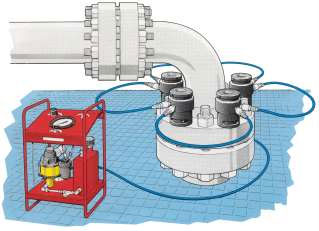The
Advantages of Stud Tensioning
When you hold a stud or a bolt, it is hard to imagine that this sturdy
object can act as a spring. In fact, the fasteners in a bolted joint
do just that. They must be stretched at assembly with enough force
to keep the joint firmly clamped together when it is placed in service.
The joint can fail if the load in the fasteners is too low, too high,
or if it is not uniform in every fastener.
Hydraulic tensioning
systems are the simple and efficient answer to this problem. It
is the tightening method that will help you control the costs of
meeting Fugitive Emission regulations by reducing leakage and extending
LDAR (Leak Detection and Repair) intervals. Hydraulic tensioning
offers these important benefits:
 Typical
Applications Typical
Applications
- Pipeline
Flanges
- Pressure
Vessels
- Valves and
Pumps
- Manways
- Heat Exchangers
- Diesel Engines
- Cranes Presses
- Steam and
Gas Turbines
- Shaft Couplings
- Coal and
Rock Grinders
- Catalyst
Reactors
Accurate
and Repeatable Stud Loading
The
theory, and practice, of tightening with tensioners is simple. A
tensioner is merely a special purpose hydraulic cylinder. The load
it applies to a stud is a direct function of the cylinders area
and the hydraulic pressure supplied by the pump. Since we closely
control these functions, the load applied to the stud is highly
accurate.
Uniform Stud
Loading
Even loading in each stud is important, especially in applications
requiring gaskets. HTI recommends multiple tensioners for applications
with more than one stud. These tensioners are coupled to each other
and to the pump. As the hydraulic pressure increases, the load in
every stud is the same, and the flange comes together simultaneously
and evenly.
Time and
Labor Saving
Multiple tensioners, working together, save time. One operator can
work most applications with a minimum of effort.
Ease of Use
and Safety
Tensioners have a high power to weight ratio. They are lighter,
less bulky and much easier to use than torquing tools. Tensioners
are quiet and are safer to use than slugging wrenches or bolt heaters.
The air or hand-powered hydraulic power supplies are inherently
explosion proof.
Increased
Stud Life
There is no thread seizing or galling with tensioning. Because the
tightening and loosening process is the same, the stud and nut threads
never see high friction loads.
|

